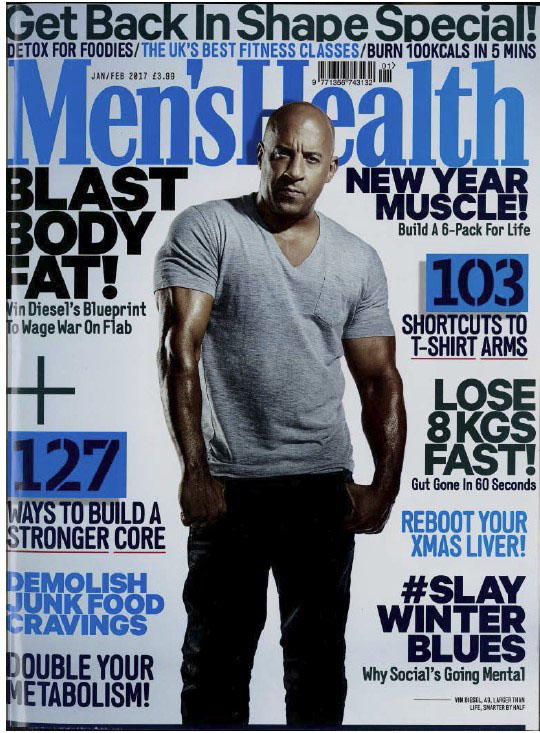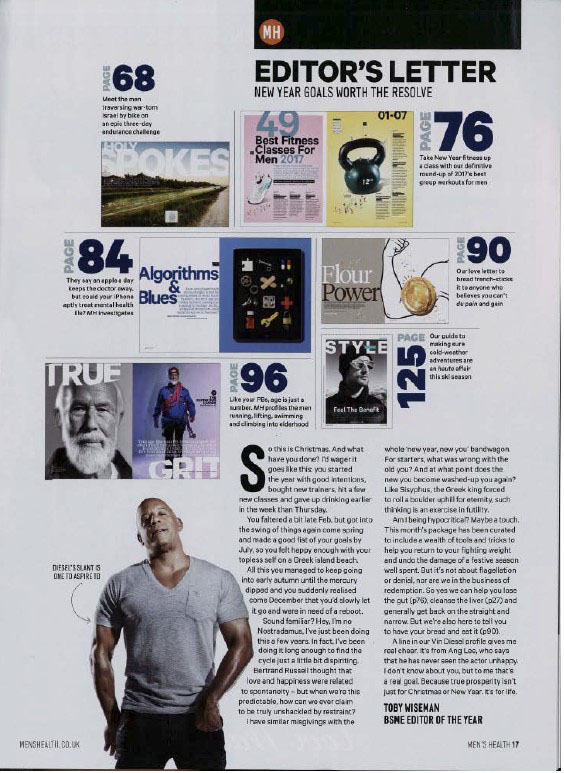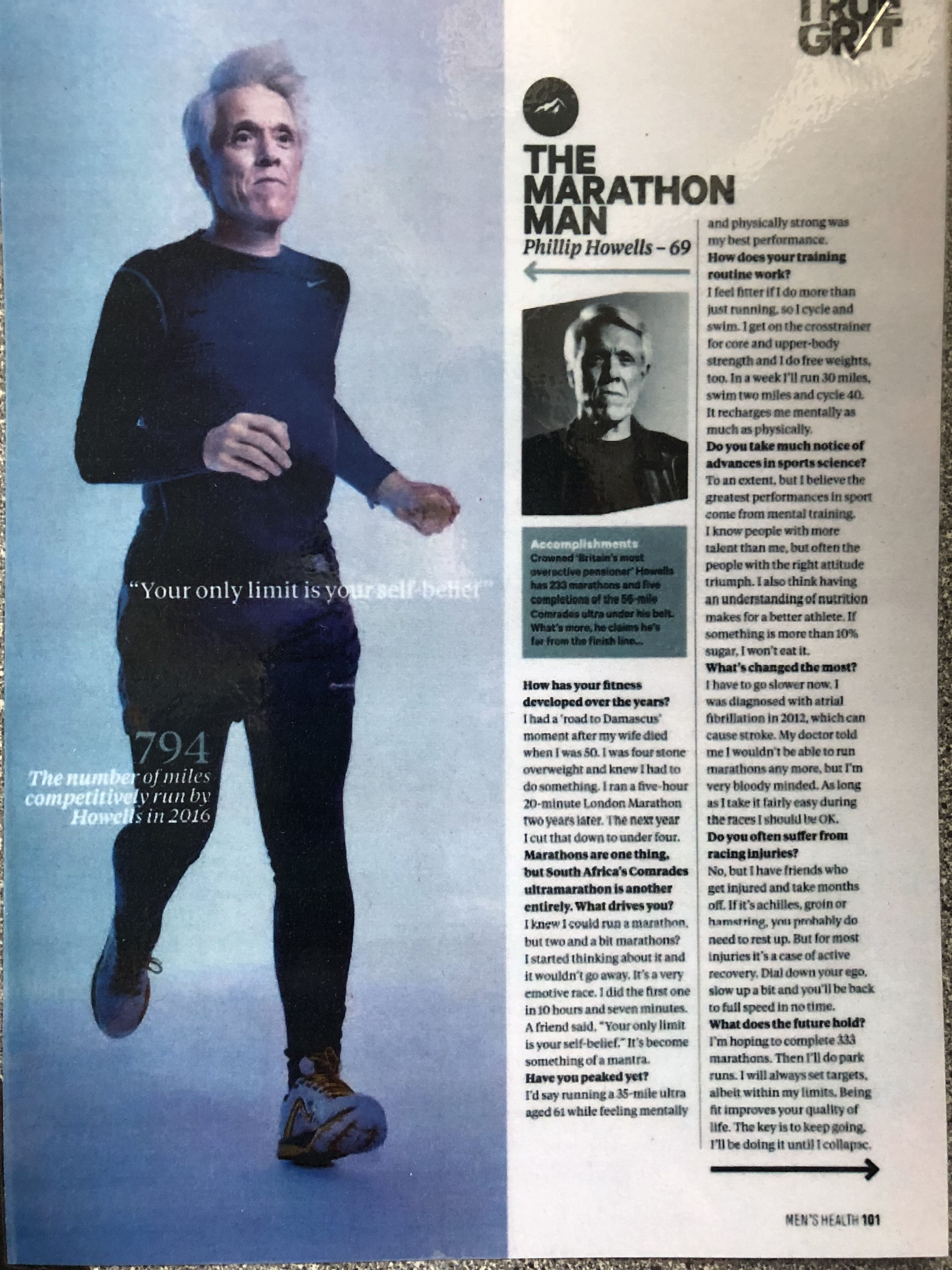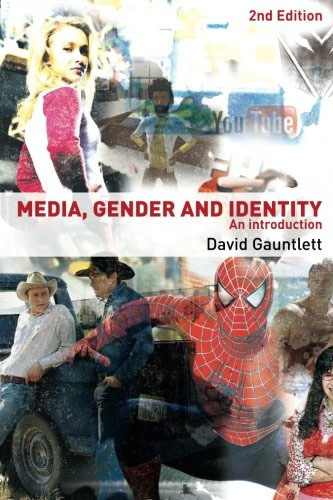The second CSP that we will look at will also fit into key theoretical frameworks of SEMIOTICS, PRINT LANGUAGE & REPRESENTATION. As before, have a look at the products, front cover, contents page and article, and discuss in a small group as to whether you consider these to be RADICAL or REACTIONARY REPRESENTATIONS OF MASCULINITY, AGE, PHYSICAL AND MENTAL HEALTH AND . . .
This is an in-depth CSP and needs to be studied with reference to all four elements of the Theoretical Framework (Language, Representation, Industries, Audience) and all relevant contexts.
Print: Magazine. The magazine should be studied in depth – the front pages and extracts from the Jan/Feb 2017 edition must be studied are shown the pages following this information.
You will also need to study the magazine in relation to Media Industries and Media Audiences. This means looking beyond the specific edition to consider issues of ownership, production, funding, technologies and regulation (Media Industries) and targeting, marketing, sales and readership, audience interpretation, fulfilment, uses and gratifications ideas and theories (Media Audiences).
Media Language
The magazine front cover and specified content should be analysed in terms of the composition of the images, positioning, layout, typography, language and mode of address etc. this will then provide detailed evidence for application of the other theoretical frameworks
Semiotics: how images signify cultural meanings
Narrative and Genre
The genre conventions of the magazine cover will need to be studied. While narrative may be more familiar to students as an approach to apply to moving image forms, it can also be very
productively applied to print media as a way of examining audience targeting, positioning and interpretation.
• Consider the way the front cover creates a narrative about character and lifestyle in order to
attract an audience
• The way in which the cover stories create enigma and anticipation for the reader – to be fulfilled by reading on.
Narratology (Structuralism) including including Todorov, Lévi-Strauss
The cover and specified content can be analysed in the context of genre in terms of conventions of layout and composition – which will overlap with analysis of visual language – but also as part
of the genre of men’s health and lifestyle magazines.
Genre study would include an analysis of the conventions of magazine front covers – a study which would overlap with visual analysis and audience positioning. Students should extend their genre approach by analysing the conventions of content of the
magazine.
Genre theory including Neale
Media Representations
Clearly the key areas of representation suggested by the magazine are to do with gender, primarily masculinity but also how this affects the representation of women. For example:
- The emphasis on male beauty and grooming challenges some conventions of traditional stereotypes of masculinity.
- The types of images selected refer to concepts of hyper-masculinity and gender as performance
- Men as object of a homosexual and heterosexual gaze
- Theories of representation including Hall
- Feminist theories including bell hooks and Van Zoonen
- Theories of gender performativity including Butler
Media Industries
The main focus for industry for this close study product is Hearst publishing, the multinational conglomerate which publishes Men’s Health and a range of other fashion and lifestyle magazines.
This will provide a case study of a commercial media institution where the primary – though not sole – focus is print.
• Case study of Hearst as a conglomerate.
• Developments in new technology mean that many of their brands are now online as well as in print – including the Men’s Health website.
• Institutional strategies for keeping print popular and relevant in the contexts of developing technology and competition from other brands.
• Cultural industries including Hesmondhalgh.
Media Audiences
As ever the theoretical framework of audience intersects with the study of visual codes and genre crucial to analysing mode of address and techniques of persuasion with the front cover functioning
as a form of advertising.
• The mode of address can be analysed through the visual and written codes
• Study of target audiences in terms of demographics and psychographics for magazines – publishing companies provide a great deal of data online in relation to their audience research for specific publications.
• The way in which different audience interpretations over time reflect social, cultural and historical contexts.
• Reception theory including Hall
Social and cultural contexts
Men’s Health magazine represents a notable social and cultural shift in expectations of contemporary masculinity (a shift which could be usefully compared with the advert for Score Hair cream). The study of Men’s Health can be linked to social and cultural contexts through reference to body image and changes in what society deems acceptable and unacceptable representations.



Task 1: The Tomb Raider games cover and the Men’s Health magazine are both print products. But they are different media forms. As such, using the Language of Print terms (see last post on Tomb Raider), make a Venn Diagram that clearly shows the similarities and differences between these two different print media forms.

Task 2: Define the following key words on a new blog post.
• Positive and negative stereotypes
• Counter-types
• Misrepresentation
• Selective representation
• Dominant ideology
• Constructed reality
• Hegemony
• Audience positioning
You should also consider some ideas on identity proposed by David Gauntlett, see his site Theory.org for more information, where he talks about: ‘Theories of identity [associated with representation]’ which from me would be the ideas around, people having a route to self-expression, and therefore a stronger sense of self and participation in the world, through making & exchanging . . .
• Fluidity of identity
• Constructed identity
• Negotiated identity
• Collective identity

Task 3: Write up a 750 word formal essay (ie beginning, main body and conclusion) that compares the representation of gender in both Mens Health and Tomb raider (draw on all of the pages and not just the front cover). Use key language and specifically show your knowledge of: 1. SEMIOTICS, 2. PRINT LANGUAGE, 3. REPRESENTATION & 4. AUDIENCE THEORY. This question is based on question 2 in your AS exam.
The question is marked out of 20. Click on the mark scheme below to see how it is assessed and look at some of the essay support documents
Post this on your blog by 9:00 on Wednesday 30th October.
GUIDANCE: Compare the specific choices that have been made in the representation of gender in the two products. In your answer, you must consider:
- how gender is represented through processes of selection and combination
- the reasons for the choices made in the representation of gender
- the similarities and differences in the representations of gender
- how far these representations are influenced by historical, social and political contexts of media.
Think about the following before and after you have completed your essay.
- Go back to your notes on the key words, phrases and ideas; reflect, expand, develop and extend your thinking and your definitions. Look at notes from other students to help you develop your thinking.
- Look at the CSP’s in more detail, try to uncover something more than the obvious or the predictable.
- Try to structure your essay so that one point links to the next and helps to build up an overall argument rather than a series of individual points. Use a range of connecting / link words (see work document uploaded to the Men’s Health post)
- Use more subject specific terminology – ie key media studies words.
- Draw upon all key theoretical areas: semiotics, media language, representation, audience theory.
- Show evidence or wider reading – my blog, the articles and videos posted etc as well as your own individual research.
- Make sure your essay has an introduction and a conclusion.
- Look to identify contradictions, confusions and difficulties – this kind of essay is not straightforward or easy, so engage and try to resolve the complications.
- Make sure your essay is long enough to really convey your argument and that you use formal language throughout.
Audience Theories
A key theoretical debate is the extent to which the media influence our ideas and opinions. In the first instance, RECEPTION THEORY (developed by George Gerbner based around research on TV viewing) suggests that exposure to reinforced messages will influence our ideas, attitudes and beliefs.
On the other hand Stuart Hall suggests that messages are actually ENCODED AND DECODED.

Stuart Hall went on to suggest that audience actually decode and interpret messages in different ways. He calls this the THEORY OF PREFERRED READING and puts forward the argument that audiences either accept the dominant reading of a text (A DOMINANT READING) or they reject the dominant reading of a text (AN OPPOSITIONAL READING), or they take up a reading somewhere in between (A NEGOTIATED READING).


